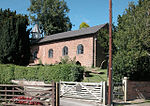St Bartholomew's Church, Barrow
Church of England church buildings in CheshireDiocese of ChesterEnglish Gothic architecture in CheshireEngvarB from September 2013Gothic Revival architecture in Cheshire ... and 3 more
Grade II* listed churches in CheshireJohn Douglas buildingsScheduled monuments in Cheshire

St Bartholomew's Church is in the village of Great Barrow in the civil parish of Barrow, Cheshire, England. It is recorded in the National Heritage List for England as a designated Grade II* listed building. It is an active Anglican parish church in the diocese of Chester, the archdeaconry of Chester and the deanery of Chester.
Excerpt from the Wikipedia article St Bartholomew's Church, Barrow (License: CC BY-SA 3.0, Authors, Images).St Bartholomew's Church, Barrow
Church Road,
Geographical coordinates (GPS) Address External links Nearby Places Show on map
Geographical coordinates (GPS)
| Latitude | Longitude |
|---|---|
| N 53.2094 ° | E -2.7957 ° |
Address
St. Bartholomew, Barrow
Church Road
CH3 7HP , Barrow
England, United Kingdom
Open on Google Maps








